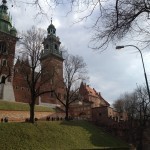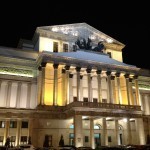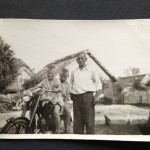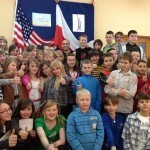Rolf Potts's Blog, page 97
May 2, 2012
Vagabonding Case Study: Lisa Lubin
Vagablogging :: Rolf Potts Vagabonding Blog
Name
Age: 39
Hometown: Chicago, IL
Quote: “I loved the momentum and near-constant adrenaline rush, but at the same time, yearned for some roots and traveled slower and slower as I went.”
How did you find out about Vagabonding, and how did you find it useful before and during the trip?
My friend had it on her bookshelf and I borrowed it in 2006 once I decided I was going to go on an around the world trip. I honestly don’t remember it specifically, but I do know it was very useful.
How long were you on the road?
For about 2 1/2 years.
Where all did you go?
Costa Rica, Ecuador, Chile, Argentina, NZ, AU (3 months), Hong Kong, Vietnam (1month), Cambodia, Thailand, Singapore, Dubai, Turkey (3 months), Romania, Budapest, Bratislava, Germany, Amsterdam, Spain, Sweden, London (1 month), New York, Chicago, Belize, Los Angeles, France (1 1/2 mos), Italy (1 1/2 mos), Egypt, Jordan, Israel, Estonia, Latvia, Lithuania, Denmark.
What was your job or source of travel funding for this journey?
Before traveling, I was a TV producer for 10-15 years. I saved a lot of money while working a ‘real’ 9-5 job. During travel, I started getting travel articles published, as well as finding jobs on the road (see next answer).
Did you work or volunteer on the road?
Yes. I wanted to do a variety of things that would allow me to immerse more in each place. I worked at a cafe in Melbourne. I taught English in Istanbul, I was a research assistant at the University of Cologne, I did Public Relations for an English-Immersion program in Madrid, and I volunteered with the homeless in London.
Of all the places you visited, which was your favorite?
The toughest question. I have several of course…The Galapagos Islands, Istanbul, Berlin, Buenos Aires, Stockholm to name a few.
Was there a place that was your least favorite, or most disappointing, or most challenging?
This one is easier. My least favorite was Dubai. Not a very budget-friendly place. It was too expensive, with a lack of public transportation and also a lack of culture…or at least hard to find, non-imported culture.
Did any of your pre-trip worries or concerns come true? Did you run into any problems or obstacles that you hadn’t anticipated?
None. I had no major issues of any kind and was thrilled with the warmth of people world-round.
Which travel gear proved most useful? Least useful?
Loved my packable rain jacket for Central/South America. Loved my headlamp. And of course will not travel sans laptop and my DSLR.
What are the rewards of the vagabonding lifestyle?
Traveling close to the ground, getting more local, and meeting amazing people.
What are the challenges and sacrifices of the vagabonding lifestyle?
Sacrificing some comforts of home and getting used to sharing your space a lot more with others.
And of course, that feeling of always being on the move, has its plusses and minuses. I loved the momentum and near-constant adrenaline rush, but at the same time, yearned for some roots and traveled slower and slower as I went.
What lessons did you learn on the road?
Mostly, that I can go anywhere in the world and build a community of friends very easily. i find that wonderful and amazing. That internet is nearly everywhere. That people are GOOD.
How did your personal definition of “vagabonding” develop over the course of the trip?
For me personally, I liked to ‘switch it up.’ Sometimes I would treat myself to a hotel to take a break from Hostelling and Couchsurfing. I was all about variety to me…to prevent boredom and burnout.
If there was one thing you could have told yourself before the trip, what would it be?
I had no idea I would be living out of a bag for four years (that’s when I finally unpacked and signed an apartment lease again).
Even though I traveled slowly, I would probably stay and live in some spots even more.
Any advice or tips for someone hoping to embark on a similar adventure?
Just do it! It is the best thing that I have ever done in my life. Most importantly, get local and meet locals…it’s these connections that are way more memorable (and lasting) that my memory of seeing sights.
When and where do you think you’ll take your next long-term journey?
Nowadays, I have a home base, but am enjoying taking month-long trips here and there. I was in Colombia for a year last year and recently spent 3 weeks in Portugal. I would love to get an apartment in Buenos Aires or possibly Berlin next.
Website: www.LLworldtour.com
Twitter: llworldtour
Are you a Vagabonding reader planning, in the middle of, or returning from a journey? Would you like your travel blog or website to be featured on Vagabonding Case Studies? If so, drop us a line at casestudies@vagabonding.net and tell us a little about yourself.
Original article can be found here: Vagabonding Case Study: Lisa Lubin
May 1, 2012
Big fat destination weddings: Exotic travel for everyone!
Vagablogging :: Rolf Potts Vagabonding Blog
Tourism, like any other industry, is evolving in many directions in order to survive. While most of us are familiar with “anti-tourism,” eco-tourism, voluntourism, and medical tourism, a growing market is emerging for wedding tourism.
 With people marrying older than they did 10 and 20 years ago, destination wedding tourism is the newest wave of big bucks to hit the industry. One in ten US weddings now fits the “destination wedding” category, as people branch away from the local church and search for something more exotic. Far away weddings carry colossal price tags and have a reputation for irking the guests who foot the bill, but tying the knot away from home is a hot new niche that doesn’t seem to be going anywhere!
With people marrying older than they did 10 and 20 years ago, destination wedding tourism is the newest wave of big bucks to hit the industry. One in ten US weddings now fits the “destination wedding” category, as people branch away from the local church and search for something more exotic. Far away weddings carry colossal price tags and have a reputation for irking the guests who foot the bill, but tying the knot away from home is a hot new niche that doesn’t seem to be going anywhere!Tourism authorities are actually pouring millions of campaign dollars into encouraging this big wedding business. Take Kasu Rajagopal Reddy as an example, who spent half a million US dollars on a double wedding and reception for his daughter in Phuket, Thailand this February. Interviewed recently in CNNGO, he states that “Thailand was chosen as a venue for the wedding as we felt that it is a ‘kingdom of dreams.’” That half a million dollars covered airfare, hotels, transportation for about 250 guests, and then the three day wedding ceremony itself. And what wedding is complete without private yachts and a flown-in DJ? While most destination wedding invitees aren’t as lucky as those attending the Reddy wedding, the Tourism Authority of Thailand (TAT) hopes that more couples will follow their lead. The TAT has been encouraging Indians to wed in Thailand for several years now, and their eyes are now set on China to boost the wedding market share. A TAT representative explains: “Last year, we had around 500 to 600 couples from China. But we will get the numbers slowly coming up.” Here’s to hoping the “kingdom of dreams” continues to lure happy couples from all over the world. I certainly wouldn’t mind tying the knot over here!
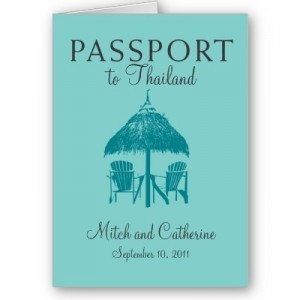
photo from zazzle
Thailand isn’t the only country hungry for a slice of the destination wedding cake. Sites like marrycarribean, gettingmarriedinitaly, destinationweddingmag, weddingsincostarica are just a few which compete to tap into the big business of saying “I do.”
So, single Vagabonders, how many of you are going to cross borders for your big day?
Original article can be found here: Big fat destination weddings: Exotic travel for everyone!
April 30, 2012
What’s keeping you from your dream?
Vagablogging :: Rolf Potts Vagabonding Blog
 As much as we want to say we’re not afraid, the truth is that we are. We might tell ourselves our fears are silly or that we shouldn’t be afraid, but we’re still paralyzed by those fears. It happens – whether we want it to or not.
As much as we want to say we’re not afraid, the truth is that we are. We might tell ourselves our fears are silly or that we shouldn’t be afraid, but we’re still paralyzed by those fears. It happens – whether we want it to or not.
In many ways fear is a good thing. Fear of getting burned keeps us from picking up hot items; fear of getting hurt prevents us from climbing things we can’t handle. Fear keeps us safe. It protects us from harm. Fear that holds us back from our dreams isn’t good, yet it stops us dead in our tracks and won’t let us go any further.
I think the best way to deal with fear is to identify exactly what you’re afraid of. Too often we don’t even know what it is that’s stopping us – it’s just the “great unknown.” Pay close attention to what scares you.
Better the devil you do know than the devil you don’t
Once you’ve identified what it is that you’re scared of, you’ll be able to attack it head on. When it’s just this nebulous cloud of “fear” you have no way to deal with it or try to overcome it. It’s overwhelming and unknown and scary.
Identify your fear, name it, then conquer it.
Click here to download my free ebook, Conquer Your Fears So You Can Conquer the World
Nancy Sathre-Vogel is mom to Family on Bikes, a family of four who recently rode their bikes 17,000 miles from Alaska to Argentina. She blogs about lessons learned from their journey at www.familyonbikes.org
Original article can be found here: What’s keeping you from your dream?
Is travel like writing your own script for life?
Vagablogging :: Rolf Potts Vagabonding Blog

Girl posing with a movie clapperboard. Photo: HerMorningElegance / Flickr
Travel is taking an active stance. Society funnels people from school to career to family. However, when you travel, you’re making a conscious decision to stop following the script that you’re given. Instead, you start to write your own script for life.
On the personal finance blog “I Will Teach You To Be Rich” (sounds scammy, I know) there was a great post on this topic: The invisible scripts that guide our lives. After reading that, I couldn’t help but think about the “script” that society says about going abroad:
It’s expensive. Only rich people do that.
It’s weird. Only hippies and backpackers do that.
It’s dangerous. You might get kidnapped and/or killed.
It’s being lazy. (Personally, I think avoiding making hard decisions is lazier.)
It’s harmful to your career. Check out this post by Alex Maccaw. He traveled around the world for a year, and got a better job than the one he had before his trip.
Got any more you can add to that list? What’s the script you wrote for yourself? Please share your thoughts in the comments.
P.S. On a complete tangent, there was a terrific comment on there by woman who arranged a low-cost, high-fun wedding.
Original article can be found here: Is travel like writing your own script for life?
April 29, 2012
Museums have long served as surrogates for travel
Vagablogging :: Rolf Potts Vagabonding Blog
“Museums have long served as surrogates for travel, a particularly important role before the advent of mass tourism. They have from their inception preserved souvenirs of travel, as evidence in their collections of plants, animals, minerals, and examples of the arts and industries of the world’s cultures. While the museum collection itself is an undrawn map of all the places from which the materials have come, the floor plan, which determines where people walk, also delineates conceptual paths through what becomes a virtual space of travel. Exhibiting artifacts from far and wide, museums have attempted from an early date to reconstruct the places from which these things were brought. The habitat group, period room, and re-created village bring a site otherwise removed in space or time to the visitor. During the nineteenth century, exhibitions delivered to one’s door a world already made smaller by the railroad and steamship. Panoramas featured virtual grand tours and simulated the sound and motion of trains and ships and the atmospheric effects of storms at sea. A guide lectured and otherwise entertained these would-be travelers. Such shows were celebrated in their own day as substitutes for travel that might be even better than actually going to the place depicted.”
–Barbara Kirshenblatt-Gimblett, Destination Culture: Tourism, Museums, and Heritage (1998)
(1998)
Original article can be found here: Museums have long served as surrogates for travel
April 28, 2012
Vagabonding Field Reports: Living the porteña life in Buenos Aires
Vagablogging :: Rolf Potts Vagabonding Blog

The streets of Palermo Soho
Cost: £20 per day. It’s not cheap here and a bad case of inflation means that prices can change weekly, but it’s defiitely possible to live on a budget. I’m renting a room in an apartment shared with an Argentinian girl in Palermo for £250 a month. You can find cheaper options further out of the city. I also bought a monthly yoga pass (£80), and I eat out about twice a week. The rest is spent on groceries, hot drinks in cafes and the odd glass of wine.
What ’ s the strangest thing you ’ ve seen lately?
Buenos Aires is one of the world capitals for plastic surgery. It’s even included in most health plans. Everywhere you go, you see women with slightly rigid looking faces.
On the other hand, if you asked an Argentine person the strangest thing they saw lately, they may well say me – I have a hole in one of my shoes and this is deeply uncouth for style-conscious porteñas – especially in trendy Palermo. People look at my shoes and then at my face – eek!
Describe a typical day.
I’m in Buenos Aires for six weeks to write and learn Spanish while my boyfriend, who I’m travelling with, makes a film in California. I wake up to a breakfast of medialunas (typical sweet Argentine pastries, often with a generous topping of dulce de leche), go to yoga and Spanish, and then back home for lunch. In the afternoon, I’ll likely share a mate, the classic Argentine drink, with my housemate, and then go set up camp to write in one of Palermo’s many excellent cafes. My favourite ones are in bookshops, complete with ladders to explore the shelves. My favourite way to spend the night is at a Puerta Cerrada, which is where someone opens their home as a restaurant, often with all the guests sitting round the same table. It’s a great way to meet locals and travellers alike. Everything happens much later here – coffee time around 7pm, dinner no earlier than 9pm, and if you’re going to a bar, 2am is the standard time to arrive.
Describe an interesting conversation you had with a local.
I’ve been to a couple of language exchange evenings, which are set up like speed dating but without the dating part. You get paired with a Spanish speaker for ten minutes, and speak for five minutes in English and five in Spanish. It’s great for practising the language and you get to have lots of random conversations. I’ve talked with people ranging from a medical student who told me the intricacies of mate drinking, to a father of five intent on learning English so he can take his family to the states. When I asked him what his daughters did, he answered with an exasperated response I imagine is common around the world: “They do Facebook.”
What do you like about where you are? Dislike?

A Buenos Aires bookshop
I’ve always wanted to come to Buenos Aires. Everyone always talked about how cool it is – an artistic, European-looking city with a Latin heart that beats to the tune of tango. It’s all of those things, but what I like most is the bookshops – there are hundreds of them, adding a literary note to the romance and passion of the city. Palermo is particularly beautiful with its tree-lined, cobbled streets and endless independent cafes, bars, restaurants and shops. It’s autumn here now so the colours are awesome.
What I don’t like, for now, is that it has all the traits of a major city – it’s busy, frantic, dirty and polluted. There’s a lot of crime and you always have to be aware of your possessions. I took the easy option and decided to live in Palermo, a middle-class area which is safer for a lone female traveller. Although I live with a local and visit other parts of the city regularly, I’m aware my day-to-day life is in a bit of a bubble.
Describe a challenge you faced.
On our first day in the city, before Steve went to California, we had mayonaise thrown at our backs on the subway. We found out when someone came up to us and offered to help clean it up. Luckily we had our wits about us, as we later found out that this is a common pickpocketing scam: one person throws the sauce and the other pickpockets you while you’re distracted and they are helping you clean up. It wasn’t the best welcome to Buenos Aires but it’s part and parcel of city life.
What new lesson did you learn?
My yoga teacher ended the class the other day by saying: “Remember each breath will never come again. We are happy because we are alive.” I like that very much as sometimes, especially when travelling, you can get wrapped up in what you’re doing next, rather than appreciating each moment as it comes.
Where next?
Next up is Patagonia. Whilst I’m enjoying the speedy wi-fi in every cafe and the abundance of vegetarian food, I’m looking forward to being on the move again and back in nature. We leave in about four weeks when Steve gets back.
If you’re interested, you can follow our journey at www.bridgesandballoons.com
Original article can be found here: Vagabonding Field Reports: Living the porteña life in Buenos Aires
April 27, 2012
Vagabonding Field Reports: Extra servings of history and kielbasa in Poland
Vagablogging :: Rolf Potts Vagabonding Blog
Cost/day: $35/day
This includes $27/day for living and exploring, plus an additional $8/day to maintain full connectivity with my business remotely.
What’s the strangest thing you’ve seen lately?
Dozens of giant statues and chapels made completely out of salt. Yes, I licked one. And yes, it was salty. The Wieliczka (pronounced Viel-eech-ka) Salt Mine, just outside of Krakow, is a seemingly endless underground labyrinth of tunnels and chambers built in the 13th century. Excavated by hand, it is over 300km long and over 300m deep. The miners used the salt as their canvas in their free time and carved statues of important Polish heroes and chapels that are still being used to this day.
Describe a typical day:
I wake up with the sunrise and have a traditional Polish breakfast of kielbasa, hams, cheeses, boiled eggs and bread with my hosts. I then grab a cup of coffee, catch up on emails and organize any work requests that came in during the night. Then, I either go into the local manufacturing company’s office where I am volunteering my consulting services, or find another place to work for a few hours. Once I am finished with my work for the morning, I go explore, talk to people, study the language, go for a jog or find a nice café or pub in the town square to read and write in. Afterward, I enjoy a lively dinner with my local hosts full of great food and conversation. Because Poland is 6-9 hours ahead of the States, depending on the time zone, I do not typically have too many work commitments until after dinner. After dinner, I usually chat with my hosts, take a few conference calls and finish up a few work projects before heading to bed.
Describe an interesting conversation you had with a local:
I was fortunate to have a cup of coffee with one of the most influential economists in Poland. He had been an advisor to the Prime Ministers of several former Soviet Union countries as they transitioned to market-based economies. We had a great discussion as he explained his views on the cultural and geopolitical reasons why Poland emerged as one of the most successful post-Communist countries and why it was the only country in Europe to avoid a recession during the global financial crisis.
What do you like about where you are? Dislike?
I love the Polish character. The country has endured more invasion, occupation and partition than most other countries in its time. Having been destroyed and rebuilt several times has left it a strong and resilient nation with a spirit for freedom and national pride. And despite all the country has experienced in its past, Poles remain very warm and generous people. The Lonely Planet said it best, “even if you protest profusely, you will be forced to polish off a bottle of vodka or two, eat plate after plate of bigos (cabbage and meat stew), and join intense discussions on philosophy and politics, but it’s comforting to know that it’s all done with a love of life and an appreciation for the present, because no-one can be sure what tomorrow will bring.”
I dislike the fact that I know just enough Polish to handle basic conversation, but am unable to communicate beyond that. And since so many people speak English, and see me as an opportunity to practice, I rarely am challenged to broaden my vocabulary.
Describe a challenge you faced:
Crossing the border into Ukraine with a borrowed car was quite challenging. The border patrol officers made me wait and answer questions for hours. They pulled me into an office and asked me dozens of questions. A few of them appeared to be tip-toeing the line of preventing a car theft and trying to get a bribe. However, after a lot of patience and a few jokes, they became increasingly friendly with me and even offered to take me out for beers in Lviv. While my patience was originally challenged trying to convince them that they didn’t have any reason to prevent me from crossing the border, I finally realized that they were perhaps just bored and looking for conversation outside of their normal routine.
What new lesson did you learn?
While in Poland, I did some digging into my family tree. I was able to trace it back six generations. I heard a full range of stories and descriptions of my ancestors. Some were inspiring, such as those who risked their lives to hide Polish Jews at their farm during World War II. Some were tragic, such as those who were executed by Germans in the town square. And some were lighter, such as everyone unanimously describing one of my great grandfathers simply as “well, he liked women and vodka.” However, whatever the situation was, I noticed that everyone’s life was described in one to three sentences. This provided me with a valuable perspective, that regardless of the many things we do and intend to do in our life, and how many more words we think it deserves, it will all be summarized in 1-3 sentences! Thinking about how I will one day be described made me realize even more how I need to live my life with purpose, character and with no regrets… yet with the humble perspective that it will still only be a few sentences.
Where next?
Africa (most likely South Africa, Mozambique, Rwanda, Tanzania, Uganda and Kenya). I structured a creative flight plan where I can fly from Poland to Dublin, Ireland (with a 3 day layover) to Dubai, UAE (with another 3 day layover) to Cape Town, South Africa for less money that it would cost to fly directly from Poland to Cape Town. This will enable me to save money AND get a taste of two other countries along the way. Perhaps I will have a Guiness in Ireleand, do some indoor skiing in Dubai and go on a Safari in Africa… all in one week! A little extra research can really pay off when traveling. If interested, you can follow my trip on Facebook, Twitter or my blog.
Original article can be found here: Vagabonding Field Reports: Extra servings of history and kielbasa in Poland
Geographic extremes
Vagablogging :: Rolf Potts Vagabonding Blog
There is nothing particularly unusual about Cabo Da Roca, no specific feature that sets it apart from the other 800+ kilometers of stunningly beautiful, cliffs-crashing-into-the-ocean Portugese coastline. But from a geographic perspective, the cliffs of Cabo Da Roca are significant: they mark the westernmost point of continental Europe.

tourists at Cabo Da Roca
When I was there last month, I didn’t find the “rugged, windswept remoteness” that the Lonely Planet promised. In fact, I couldn’t even get a picture to fake the windswept remoteness. I tried. But there were so many tourists in my shot that I quickly gave up, and instead amused myself by taking pictures of people taking pictures.
What is it that draws us to geographic extremes, places that are unexceptional from the ground but hold some sort of cartographic significance?
The blockbusters are easiest to understand, as they’re some of the most awe-inspiring points on the planet: there’s the highest point on earth (Mt. Everest) and the lowest (Dead Sea), the longest river (Nile) and the biggest (Amazon), the driest dessert (Atacama) and the largest one (Sahara), not counting Antarctica. These places are, justifiably, at the top of many “must-see” lists.
But then there are the B-listers, places you’ve never heard of unless you happen to be traveling nearby. Like Cabo Da Roca. Or the nearby Cabo de Sao Vincent, several hundred kilometers away, which marks the southwestern tip of continental Europe. Every continent and every country has a directional extreme, and within it, every region has a highest mountain or a largest lake or a highest waterfall.
Maybe I’m just a geography nerd, but I still think there’s something cool about visiting the B-listers. Like Kanyakumari, which marks the southern tip of India. Sure, there’s not much to do there, it’s hard to get to, and it’s not as beautiful as other coastal points in the area. But it’s precisely at these geographic extremes that you are forced to imagine your place in the world at that very moment—and it’s hard not to be blown away by the enormity of the planet and your tiny, speck-like existence upon it.
Original article can be found here: Geographic extremes
April 26, 2012
Beautiful Little Beaune
Vagablogging :: Rolf Potts Vagabonding Blog
Beautiful Little Beaune
James Ullrich
The picturesque little city of Beaune, nestled in the fertile green vineyards of Burgundy, is a handy home base for exploring the region. While the surrounding area holds tiny hamlets and ruined abbeys, I’ve found Beaune to be a good option when in need of a historic place to stop, wander, and spend a few nights between forays into the countryside. It just feels comfortable. But even if you’re just passing through, it’s worth a wander in and of itself.
Pulling into town you’ll see signs for the Hotel Dieux, but don’t show up with your luggage and try to check in. The stunning six hundred-year-old building is not a hotel at all; it’s a medieval charity hospital. A wealthy local funded the construction in the wake of the plagues that ravaged Europe in the fifteenth century. Entire families were killed off, and many of the region’s surviving inhabitants were left destitute. Notice the intriguing woodwork patterns in the Gothic structure; it remains in incredibly good condition. There are several well-preserved rooms that offer a glimpse into how the medieval sick were cared for in a prosperous town. There is also some priceless art work and an interesting exhibit on its former life. Many of the area’s poor residents checked in; few checked out.
It’s hard to appreciate Beaune’s history and culture without appreciating the role of its wine trade. As Burgundy rivals Bordeaux in terms of production of top-quality wine, there is of course plenty of good wine to be had in and around town. The Museum of the Wine of Burgundy is a requisite stop, boasting a model of the medieval town and exhibits on the town’s long and varied history. It’s a good opportunity to understand why the vino trade was so much a part of the region’s heritage. After all, wine was the lifeblood of the city’s prosperity. It paid for the elegant medieval homes and churches surrounding you and the cobbles under your feet.
No French town would be complete without an ancient church, and the seven hundred-year-old Collégiale Notre Dame fills the bill beautifully with exquisite stained glass windows. I’ve always found old churches to be ideal spaces for escaping crowds, late afternoon heat, and the rush of modernity. Take the opportunity to sit down in the Romanesque landmark and contemplate as the sunlight filters through the colorful stained glass, causing a kaleidoscope to dance on the soaring stone columns.
If you’re in town on a Wednesday or Saturday, enjoy the colorful market happening on the place Carnot, just as it has for centuries. It’s hard to miss—most of the Beaune’s roads lead to it.
After a fine dinner and a restful night’s sleep, venture into the country lanes again, maybe heading to picture-perfect Château de la Rochepot, historic Cluny Abbey, or just joyriding past villages that have no name. Beaune is well-situated at the intersection of some of the area’s main roads, so with a car and a good map you’ll be able to get out of town and amongst the vineyards in no time (just don’t get stuck on the ring road). If you’re lucky enough to find yourself in the neighborhood, consider checking it out.
Original article can be found here: Beautiful Little Beaune
So what’s it like to Couchsurf in Asia?
Vagablogging :: Rolf Potts Vagabonding Blog

Picture credit: http://www.theexpeditioner.com
A few weeks ago, Marcus Sortijas published an interesting piece on Vagabonding describing the Couchsurfing experience in the United States. As I am a Couchsurfing aficionado and have travelled more than 10 Asian countries using it, I would like to spend some words describing how this beautiful service works in another side of the world.
I would like to start introducing an important, ever present concept in Asian societies: a guest is considered as a gift from the Gods. Of course, only when it is a real, genuine guest. I feel important to describe this duality, because Couchsurfing in Asia works on the same, subliminal dualistic level: it is either great, or totally awful.
Why? Because you may be very lucky and get to experience unique moments of true hospitality and kindness with some of the most humble, accommodating people on earth. Or you may end up in the hands of some businessman – tourist operator, tour guide, hotel manager, shop owner, restaurant owner etc. – interested in giving you a free – and sometimes dirty – bed in order to push his/her services.
On account of my personal experience, most of this “second category” people are to be found in the Indian Subcontinent: flashy profiles peppered with a bunch of predominantly local users’ references are generally marks of the Devil. To cite an example, in mid 2010 me and my girlfriend visited Alleppey, Kerala. We were welcomed by an apparently friendly Couchsurfer who took us to an ayurvedic center he was working at. We were accommodated in a dirty room which probably caters to paying guests during the regular season, when it is actually cleaned and functional: there was no electricity for the best part of the day. That night we spent simmering in the horrid heat – our bodies the feast of a thousand mosquitoes biting as hard as a gang of hungry living dead – still remains one of our fondest travel horror stories.
This Couchsurfer talked to us for about 10 minutes during the whole stay, and tried to sell us a Backwaters’ tour a few times before giving up. At last, as we were about to board a little boat hours after our arrival, we found out that our host wanted to charge us three times the going rate.
Nevertheless, like the ying and the yang, Couchsurfing in Asia – and also in India, let me clarify – can also be a dreamy experience: to give some credit to Indian Couchsurfers, I must say that I have also received some of the most amazing hospitality in this country, and have been able to exchange deep, meaningful relationships with its Couchsurfing community. I have been treated as a family member, almost spoon fed daily – and free of charge – and brought to experience places and situations as deeply as it can get.
I have got to know Couchsurfers’ family members as my own, and have been helped immensely in many aspects of my vagabonding. If this is not enough, I can also tell you that the reason why I met my lovely girlfriend and settled down in Malaysia is only because one odd night I decided to attend a Couchsurfing meeting in Penang!! So, for this and many other reasons, I can just recommend using this amazing community as you travel across Asia because it still gets you the easiest and purest access way into Asian cultures: as the members are English speaking locals looking for a genuine interaction, you will be able to receive a real insight into their lives and homes.
And if it is not… oh well, horror Couchsurfing stories make great conversation topics at the bar back home. People will look you in a different way after you told them you survived a night at the horrific ayurvedic clinic… or that you slept in the nest of a tour guide viper trying to poison you with a bunch of hiking tour options… and most importantly: happy surfing in Asia to anyone!!
Original article can be found here: So what’s it like to Couchsurf in Asia?
Rolf Potts's Blog
- Rolf Potts's profile
- 323 followers








